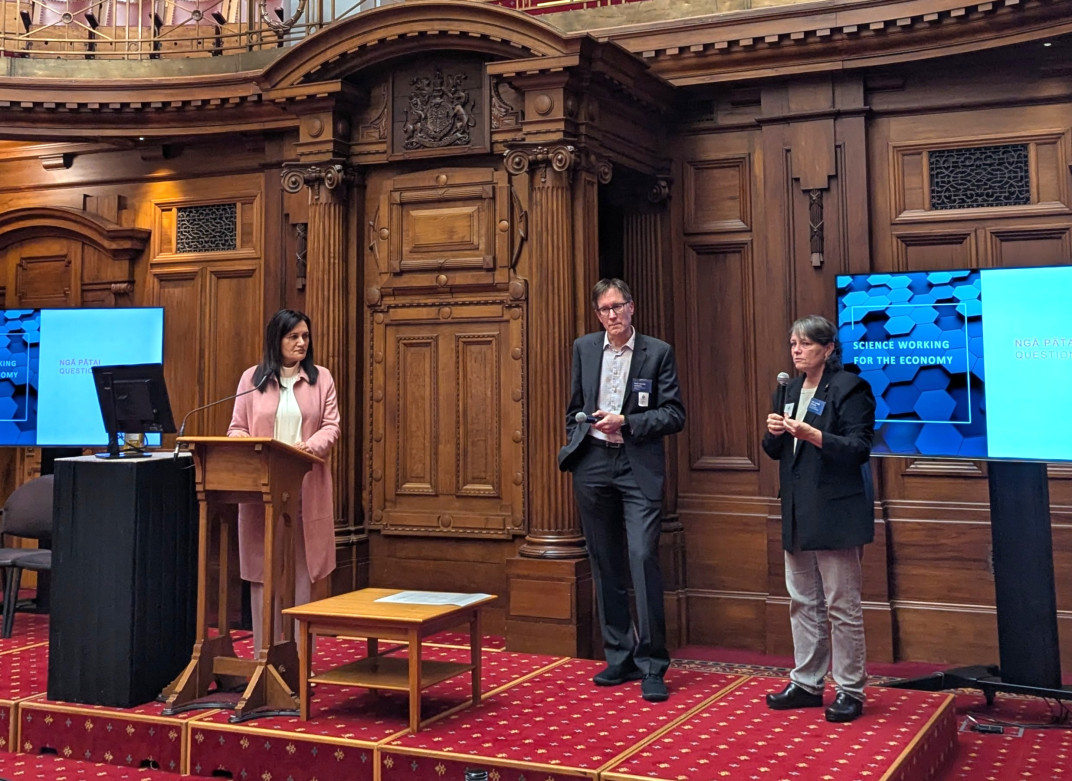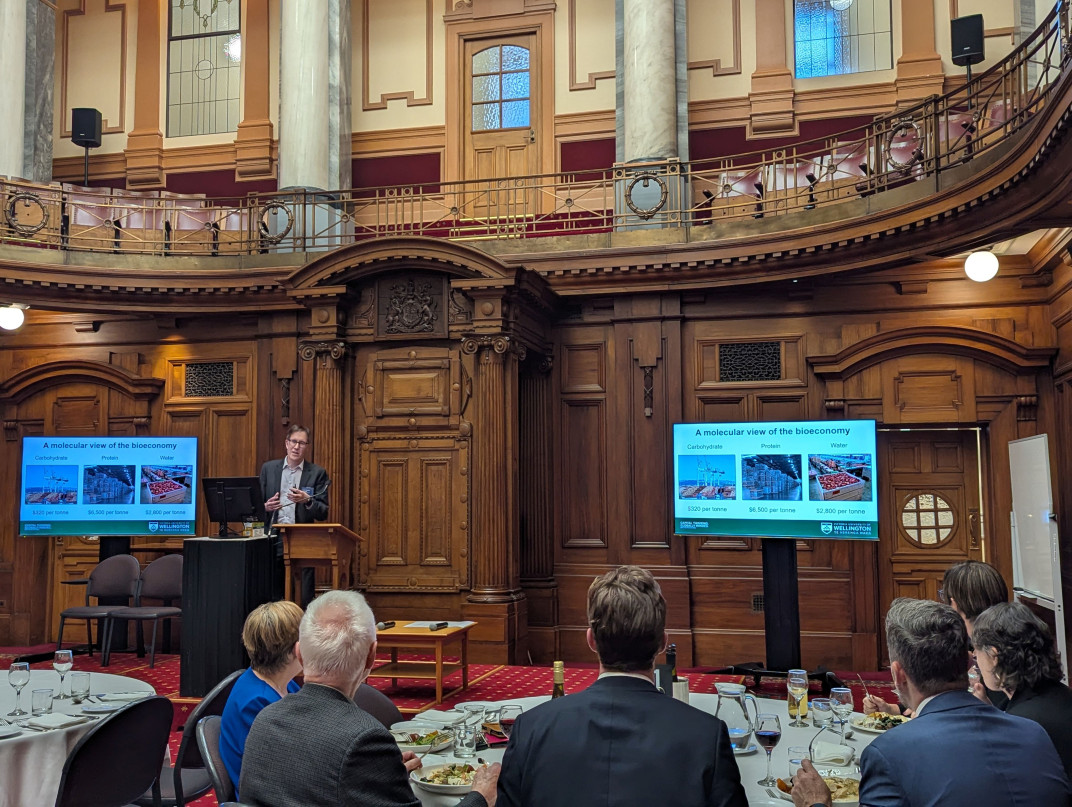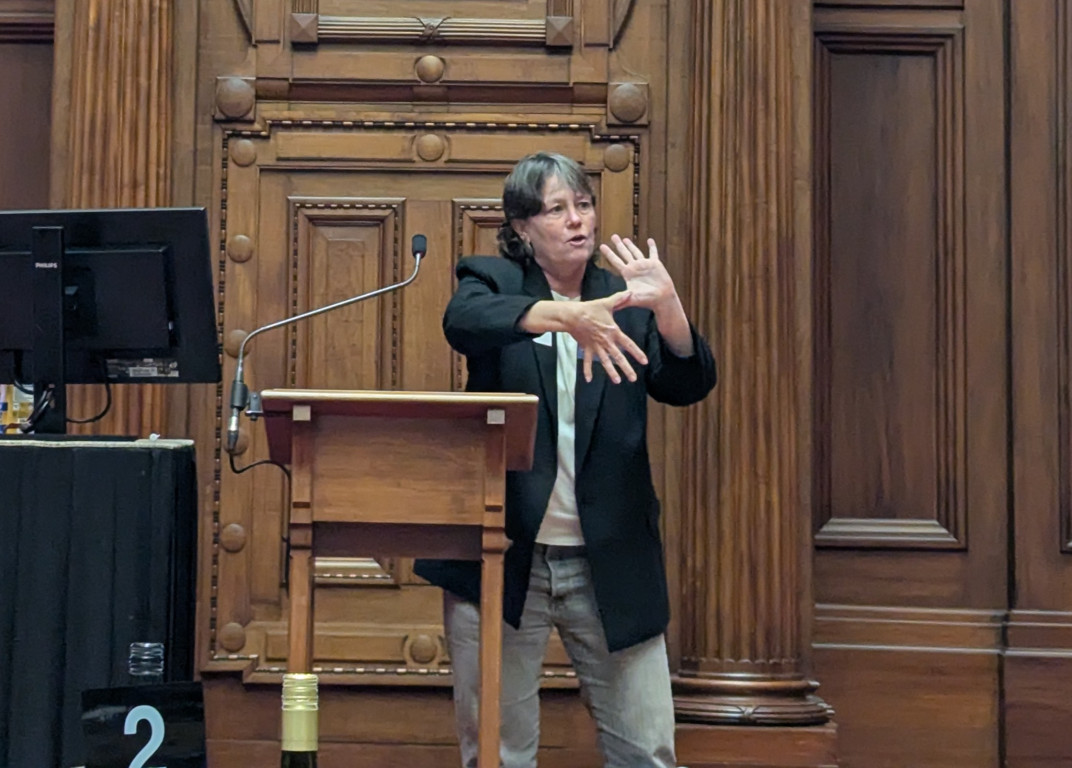Science working for the economy
2025's final event was on 14 Whiringa-ā-rangi October. MPs engaged with researchers at different stages of commercialising their work. Professor Wayne Patrick pitched high-value biochemicals like enzymes as a future important export and Professor Cather Simpson FRSNZ described four start-ups she has founded based on her expertise in photonics (lasers).

Dr Parmar, Prof Patrick, and Prof Simpson during question time
An ultra high-value future for the New Zealand bioeconomy
Professor Wayne Patrick, Te Herenga Waka – Victoria University of Wellington
From a biochemist’s perspective, New Zealand’s economy is dependent on our ability to export biomolecules. We lead the world at efficiently producing a carbohydrate named cellulose (ie logs), as well as the proteins casein and whey (milk powder). We are lauded for our ability to produce delicious, dilute aqueous solutions of flavour and aroma compounds, with added sugars (fruit) or ethanol (wine). As a nation, we produce millions of tonnes of these biomolecules and ship them to distant markets, where they sell for hundreds or thousands of dollars per tonne. However, there are other biomolecules that are much, much more valuable and Professor Patrick compellingly argued that we are perfectly positioned to grow our exports of these.
He began by introducing enzymes. These are the "amazing" proteins that catalyse biochemical reactions. They are highly specific, sensitive, and they accelerate reactions by more than 20 orders of magnitude (i.e. by 100,000,000,000,000,000,000-fold). These properties make enzymes essential for every organism on Earth. It also means they are increasingly valued as powerful tools for biotechnology. Familiar examples are the ‘hungry enzymes’ in laundry detergents and the enzyme-based biosensors used by diabetics to monitor their blood glucose.
In his first case study, Professor Patrick outlined research in his laboratory to invent a new biosensor for winemaking. His team leveraged their fundamental knowledge of enzyme structure and function, and also worked closely with New Zealand winemakers to ensure the final product was fit for purpose.
Next, Professor Patrick touched upon the AI revolution in protein biotechnology. Nobel Prize-winning tools increasingly empower us to design wholly new proteins with user-defined functions. These tools are catalysing a wave of creativity as biotechnologists (especially the ambitious and talented early-career ones!) innovate and invent at unprecedented pace. In his second case study, Professor Patrick explained how his team is using AI to push the boundaries in vaccine design.
Finally, Professor Patrick provided a bullish assessment of the opportunity. New Zealand’s universities have a pipeline of talent and—increasingly—critical mass in protein biotechnology. Recent investments in the Bioeconomy Science Institute, such as Rotorua’s new BioFactory, will make it possible to manufacture ultra high-value proteins at scale from low-value waste streams. Now is the time to reimagine the New Zealand bioeconomy.

Professor Wayne Patrick speaks to MPs
Hard Science & Technology – Return on Investment
Professor Cather Simpson FRSNZ, CEO Orbis Diagnostics, University of Auckland
Dr Cather Simpson, Professor of Physics & Chemistry at The University of Auckland, CEO of Orbis Diagnostics, and Partner at investment firm Pacific Channel is a fundamental chemical physicist turned co-founder of three (soon to be four) photonics startups. She sits on the boards of the Dodd-Walls Centre for Photonic & Quantum Technologies, Fisher and Paykel Healthcare, SPIE the International Society for Optics and Photonics (where she is currently Vice-President), and several deep tech startups.
Professor Cather Simpson’s talk about the benefits to the economy of investing in deep science and technology turned out to be quite timely. The morning of her presentation, the 2025 Nobel Prize in Economics was awarded to Professors Joel Mokyr, Philippe Aghion and Peter Howitt for demonstrating how new technologies can drive sustained economic growth. The same day, Aotearoa New Zealand’s Minister of Science, Innovation and Technology, the Honorable Dr Shane Reti, announced a sweeping overhaul of the science and innovation funding system so that "our researchers can spend … more time on discovery, innovation, and results that will grow our economy and benefit New Zealanders".
Dr Simpson elaborated some of the defining characteristics of deep or hard technologies, including the focus on solving major challenges with innovative new science and the creation of intellectual property depth that provides a barrier to would-be competitors. Examples of deep tech innovations include the internet, automobiles, quantum tech and photonics, artificial intelligence, synthetic biology, and (her favourite) the laser – all tangible objects or processes that drive productivity growth through step-change transformations in the way great things are achieved.
Soft tech, in contrast, drives efficiencies and improvements through clever use of known technological approaches or processes. Examples of soft tech include software as a service (SaaS), consumer apps and business software. Soft tech drives economic growth through a “rising tide” effect. It tends to be more vulnerable to competitors but can require lower capital investment and provide faster returns.
Dr Simpson provided insight into return on investment through the multiple lenses of university spinouts, venture investment, and established deep and soft tech companies. She illustrated the New Zealand context with relevant examples of spinouts from her laboratory, the Photon Factory, at the University of Auckland, her experience as a partner in an investment firm, and head-to-head comparisons of the performance some of New Zealand’s most significant deep and soft tech companies.
Her conclusions were that, while New Zealand needs both deep and soft tech, deep tech can deliver stronger, longer-term returns on every dollar invested. That investment needs to be consistent – slow and steady wins the race with deep tech, because of the need to build expertise and tangible technology. It’s not just dollars, either. The “levers” need to be set right to foster growth in technology innovation while continuing to support national strengths like the primary industries.
Finally, and perhaps counterintuitively, to sustain the steeper productivity growth that New Zealand needs, a balanced portfolio of investment must include strong, consistent support for fundamental science education and research, so that the country has the right people with the right ideas to drive future innovations on 5-, 10- and 20-year horizons. Commercialisation is only the last step in the innovation process. It’s not enough to build the first steam engine. It’s the people who deeply understand the fundamental science and engineering who invent the new and better engines – and beyond – solving the world’s big problems while underpinning sustained productivity growth for New Zealand.

Prof Cather Simpson describes chemical bonds responding to light.
